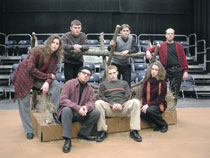New play portrays real citizens, true events

30 p.m. It is based upon the 1998 murder of Matthew Shepard.
Clockwise from left, Amy-Nicole Hallenburg, Aaron Stockton, Brandon Painter, Drew Fethers, Rachel Mastic, Donald Leffert and Kris Stokes are seven of the 12 people acting in The Laramie Project. The play runs through Saturday at 7
Oct. 6, 1998: two boys, Russell Henderson and Aaron McKinney, kidnap and beat 21-year-old Matthew Shepard, a homosexual University of Wyoming student, to death on the outskirts of Laramie.
Later that year, nine members of the Tectonic Theater Project, along with Moisés Kaufman, begin a series of more than 200 interviews with the citizens of Laramie.
The Missouri Southern theatre department is now presenting the product of the Tectonic Theater Project’s six trips to Laramie. The Laramie Project, which has been running since Jan. 21, will close with performances at 7:30 p.m. Friday and Saturday in the Black Box Theatre.
The characters in The Laramie Project are not works of fiction but actual people living in the town of Laramie.
The play documents their reactions during the beating, hospitalization and death of Shepard.
“The play is is not about homosexuality at all, but about how these good citizens of Laramie dealt with that,” said Dr. Jay Fields, director. “The play is about learning to be tolerant. The play is about acceptance. The play is about dealing with hate crimes.”
Despite Fields’ claims, some of the actors initially focused on the sexuality of their characters.
“I think everyone, and I as a sophomore, had hang ups about playing homosexuals,” said Rachel Mastin, who primarily plays Catherine Connolly.
After the development of her primary character, Mastin said Connolly was no longer a lesbian or straight, but simply a person.
In addition to dealing with characters of varying sexualities, the performers also have to play multiple roles.
There are 62 characters to portray and only 12 actors to portray them. The original production of The Laramie Project had even fewer actors.
Because of the emotions involved in the show, Fields decided to perform the play in a round — a setup in which the audience sits in a circle close to the actors in the center.
“I wanted the actors to be able to get in the audience’s faces,” Fields said.
Fields also decided to have “talk backs” after every show in which audience members have the opportunity to discuss with the crew the show that has just been presented.
After weeks of practice, the actors themselves still get caught up in the emotion of the story.
“We have some tears in that final circle every night,” Fields said.
Mastin agreed; it is the emotional and, for her, the sensitive subject matter of the show that drew her toward this play.
“You know how you can’t take your eyes off a car crash? It’s just one of those plays everyone would want to see,” Mastin said.
Fields was unsure of the reaction the play would receive from the community, but he was aware of how it was taken elsewhere.
When the play first began appearing, Fred Phelps, a minister, went to shows around the country with a group of followers touting signs like “God hates fags” while singing “Amazing Grace.”
Despite the community’s reaction, Fields is sure of one thing.
“When you leave that play, you will see something of yourself in those people,” he said.
“You can’t not.”
Your donation will support the student journalists of Missouri Southern State University. Your contribution will allow us to purchase equipment and cover our annual website hosting costs.



























